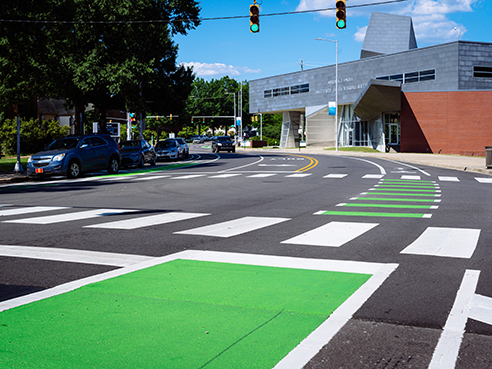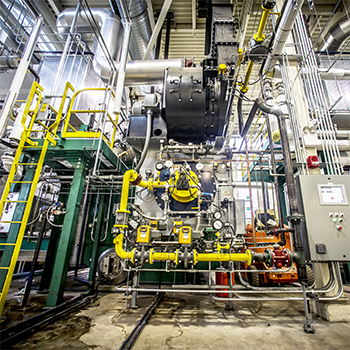 The 10 city blocks along 10th Avenue South between Eighth and 18th streets now feature brightly painted bicycle lanes and crosswalks.The southern side of campus is more bike- and pedestrian-friendly following a year-long redesign of 10 city blocks along 10th Avenue South between Eighth and 18th streets to include brightly painted bicycle lanes and crosswalks.
The 10 city blocks along 10th Avenue South between Eighth and 18th streets now feature brightly painted bicycle lanes and crosswalks.The southern side of campus is more bike- and pedestrian-friendly following a year-long redesign of 10 city blocks along 10th Avenue South between Eighth and 18th streets to include brightly painted bicycle lanes and crosswalks.
Tenth Avenue likely was widened as part of a 1970s urban renewal effort to accommodate increased traffic flow, says Geoff Boyd, director in UAB Facilities Planning Design and Construction, but as UAB has grown, reimagining the road became necessary. Through a process known as a road diet, UAB Facilities Division narrowed the four-lane road to three — one eastbound, one westbound and a center turn lane — to create a new cycling lane on each side.
|
“The road diet provides a combination of slowing traffic, which makes it safer to walk, while also providing dedicated space for alternative modes of commuting, such as biking and walking.” |
The project also improved the 10th Avenue intersections at 13th and 17th streets in UAB’s cultural arts corridor. At 13th, the highly trafficked intersection bordered by the Alys Stephens Center, Mervyn Sterne Library, the Alumni House and the Abroms-Engel Institute for the Visual Arts (AEIVA), street width was reduced 16 feet total, shortening the pedestrian crossing, Boyd says. The same was done at the 17th Street intersection, where Residence Hall 2020 is being constructed, and a traffic light was added to provide dedicated crossing time for pedestrians.
“Road diets generally slow vehicular traffic, which makes it safer for our folks to walk while also providing opportunities for alternative modes of circulation, such as biking and walking,” Boyd explained.
Celebrate the newly completed project during a ribbon-cutting event 9 a.m. Aug. 1 in front of AEIVA.
UAB Sustainability’s strategic plan, implemented this past fall, outlines UAB's commitment to reducing employee-alone commuting, vehicle traffic and auto emissions on campus, and the university’s strategic plan, Forging the Future, reinforces that commitment by encouraging environmental stewardship. The 10th Avenue road diet plays a key role in achieving those goals, Boyd says, adding that UAB senior leaders were vocal champions of the road diet project.
|
“Green lanes aren’t just cool because of UAB — it’s become an industry standard. … If you see a bigger, brighter crosswalk, you’ll know you’re on UAB’s campus.” |
“There’s an emphasis on pedestrian movement on campus,” Boyd said. “As we push for less dependency on cars, it’s important we provide other options for circulation.”
UAB partnered with the City of Birmingham to develop the roadway design and used national standards and best practices. The bike lanes are painted bright green and crosswalks are painted with bright white dashes. Green lanes have become an indicator of cycing lanes across the United States, Boyd says, but at UAB, they have an added benefit — inspiring Blazer pride.
“Green lanes aren’t just cool because of UAB — it’s become an industry standard,” Boyd said. “The bright crosswalks are common across the U.S. in dense locations, providing better visual cues for both pedestrians and vehicles, but here it gives us a bit of a brand and a clean delineation of where in Birmingham you are. If you see a bigger, brighter crosswalk, you’ll know you’re on UAB’s campus.”

 Centralizing campus utilities
Centralizing campus utilities